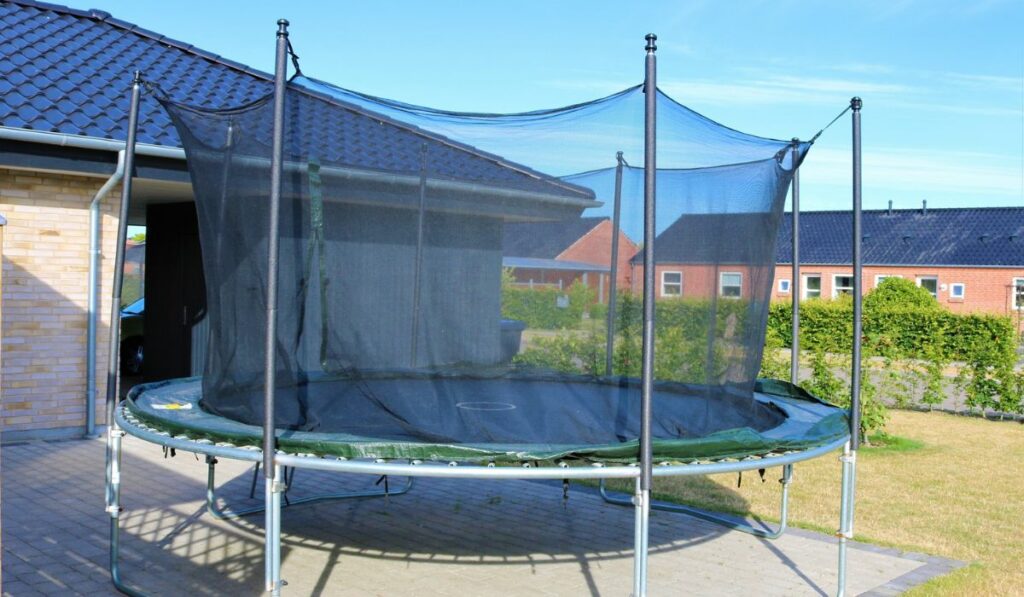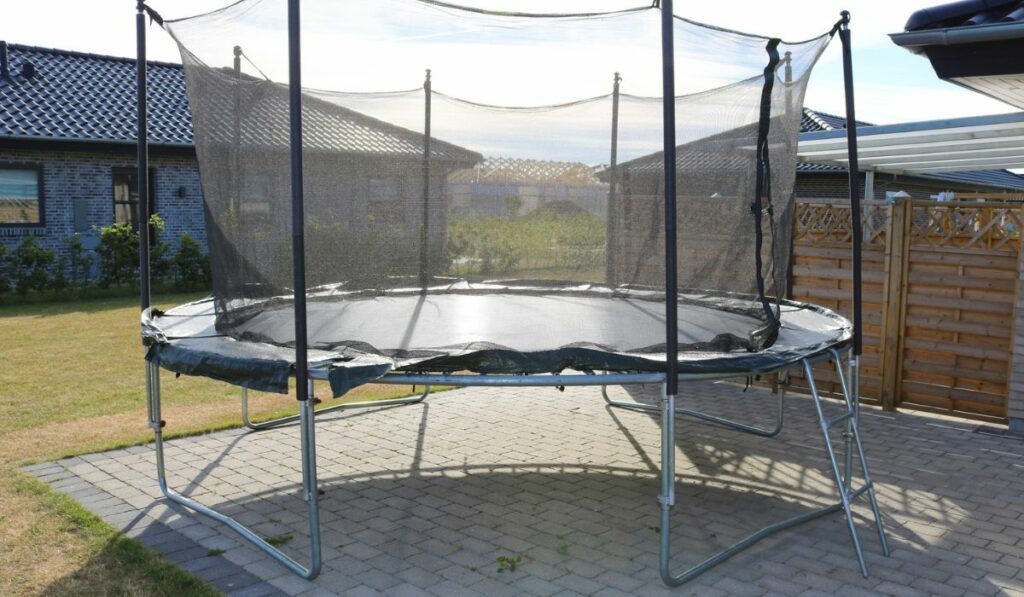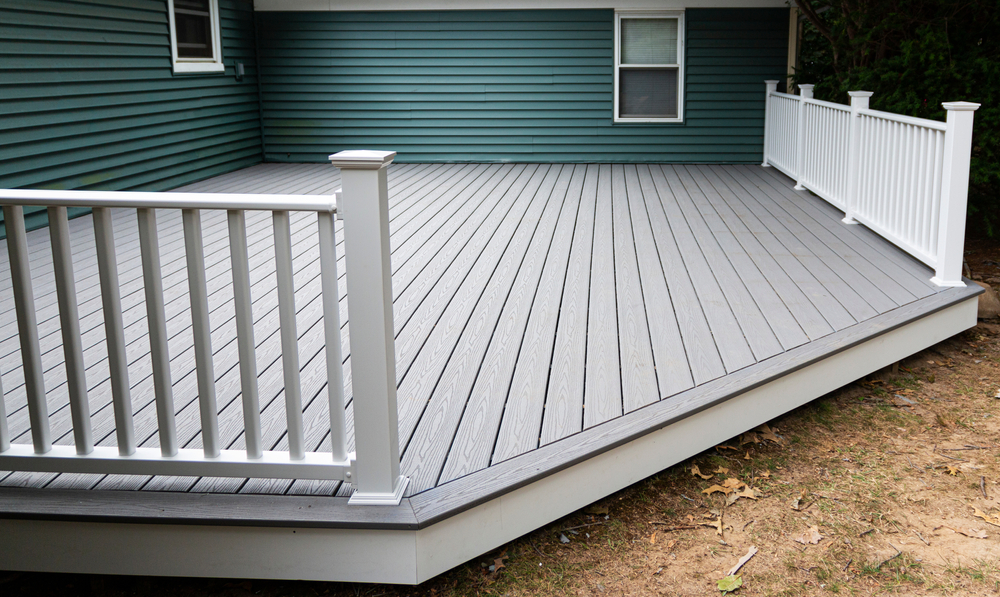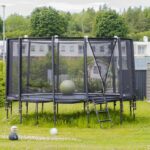Even a tiny hole in your trampoline can take away the fun of bouncing on it or even make it dangerous for your kids. And if you let your kids jump on it without patching up the hole, it’ll only get bigger and bigger, and eventually, you’ll have to replace the whole jumping mat.
There are three ways to fix trampoline holes. You can use a cross stitch or whip stitch to sew the hole using a patch. You will need a trampoline repair kit for this. Alternatively, you can use flex tape or an adhesive patch to fix the hole. Or you can call the professionals.
Let’s look at the step-by-step instructions on how to sew the hole with a patch using a whip stitch and a cross stitch, how to use flex tape to fix the hole, and how adhesive tape can help. We’ll also see when you should call a professional and how to prevent holes in the first place.
Method 1: Sew the Hole with a Patch

The first way to repair a hole in your mat is to sew a patch onto it. It might be a little complicated, but it provides excellent results. You should get a trampoline repair kit instead of buying all the supplies individually since it’s more pocket-friendly and effective.
Most trampoline repair kits have durable industrial needles, heavy-duty thread, and UV-resistant patch sheets made using canvas. Here’s how you can sew the hole in your trampoline using a patch:
- First, make sure you get someone to help you out. While you can sew it yourself, it’s more effective if two people do it. Plus, you get better, tighter results.
- One of you should stand on top of the trampoline while the other should stand below it. Now you need to feed each other the needle. You’ll need needle-nose pliers like this one from Craftsman (on Amazon).
- Next, cut a circle using the replacement patch included in the kit, but make sure it’s 2 inches wider than the tear you want to fix so there’s some overlap.
- Before you put it over the hole, run a matchstick or lighter across the edges of the replacement patch to prevent fraying.
- Place the patch on top of the hole and pin it to keep it in place as you sew it. Now, you can start sewing it with the mat directly using either a whip stitch or a cross stitch.
Make sure you tighten the thread to ensure further stability. Most replacement patches come with instructions on how to sew them over the hole. Ensure you read those thoroughly so you don’t do anything wrong.
How to Do a Whip Stitch
A whip stitch is quite famous for its durability and prevents the fabric from coming apart. Here’s how you do a whip stitch:
- Thread the needle and make a knot. Since the whip stitch is angled, you should start as close to the edge of the replacement patch as possible, especially if you’re sewing straight across.
- Push the needle through the replacement patch, so the knot ends between the patch and the trampoline.
- Move the needle on top of the seam and take it back through the replacement patch and the trampoline so it comes right underneath the first stitch you made.
- Next, you need to make an angled stitch. For this, take the needle through the back of the previous stitch and push it out the front of the replacement patch, roughly around 1/8th to 1/4th of an inch away from the previous stitch.
- When you pull the needle through, you’ll see a loop that should cover the first stitch.
- Now follow the same steps for the next stitch. Insert the needle at an angle, but make sure it’s right behind the previous stitch. The needle’s tip should come out about 1/4th-1/8th of an inch from the previous stitch on the front.
- Continue the same way until you reach the sand. On the last stitch, make sure you push the needle’s tip between the two pieces and tighten the stitch.
- Separate the thread strands, make some knots, and tighten them until they disappear between the two pieces.
- Finally, trim the ends of the thread as close as possible.
How to Do a Cross Stitch
A cross stitch is also relatively easy, even if you’ve never done it before. Here’s what you have to do:
- Cut the right size of the replacement patch and thread your needle with your choice of heavy-duty thread.
- To make the first cross stitch, push your needle from the bottom of the trampoline. Pull it all the way through the replacement fabric, but leave a small loop at the bottom. Cross the thread diagonally up or down, and then pass the needle through the loop at the bottom to make an anchor for the stitching.
- You can start your cross stitch from right to left or left to right; it doesn’t matter as long as you follow the same pattern throughout the project.
- Use the same ‘x’ pattern to stitch the replacement patch to the hole. And if you run out of thread, you can tie a knot at the back and cut a new piece.
- Once you’re done, tie off the thread underneath the cross stitch. Then, make a simple knot at the back of the pattern and cut off the extra thread.
Method 2: Use Flex Tape
If sewing is not your thing, if you find it too difficult, or if you need a quick way to repair the hole in your trampoline, then using flex tape is the most effective option. You can find flex tape in many colors and sizes so that you can choose one according to the hole size.
The great thing about flex tape is that it’s weatherproof, so it’ll stick to the trampoline even if wet. The process is also quick, long-lasting, and inexpensive (it doesn’t cost more than $50 in total, which is way less than what a new mat costs). Plus, it’s better than using duct tape.
Applying flex tape is pretty straightforward. All you have to do is apply the tape on the tear, both on the bottom and the top. Then spray it with a flex spray to seal it, and let it dry.
Method 3: Use an Adhesive Patch
Perhaps the easiest and (unsurprisingly) most common way of repairing a hole in your trampoline mat is to use an adhesive patch. However, you should note that adhesive patches are usually available in oval or round shapes and are more suitable for smaller holes (typically around 3” or smaller).
Here are step-by-step instructions on how you can use adhesive patches:
- You first need to find all the holes and tears in the mat and make a mark around them using chalk. Do this for all the holes you can spot.
- Open up the box of adhesive patches. For each hole, cut a patch 2 inches wider than its diameter using scissors. Slightly larger patches will ensure there’s some room for overlapping.
- Use a ruler or tape measure to measure the cutting patch. Then, cut the same size as the patch using the extra tarp. However, this isn’t necessary to do so every time.
- Put the cutting patch over the hole and use pins to hold it in place. Then use a thread and needle (or embroider) to stitch the ends of the patch to ensure better tear resistance. Do this on both sides. This step is also not mandatory.
- Use a damp cloth and clean the surface of the patch and the surface of the mat surrounding the hole.
- Glue around and over both the patch and the hole. Your glue should be more than 5-10 mm wider and 1.5 mm thicker than the hole.
- Press the patch to the mat for 1-2 minutes to attach the two. The two surfaces should make complete contact.
- Leave the patch for around 12-24 hours to dry, harden, and settle.
While using adhesive tape is easy, there are many drawbacks to it. This process takes much longer than sewing a patch since you must first wait for the glue to dry and cure. And if you live somewhere cold, the glue might not cure correctly since it needs a temperature of more than 41 degrees Fahrenheit.
When to Hire a Professional

There are many cases where you can hire a professional. For example, now that you’ve looked at a few DIY ways of fixing the holes in your trampoline, you might be overwhelmed by the idea of repairing it yourself. Or you might not be comfortable doing so or don’t have the time for it.
Also, if the holes in your trampoline are more than 3-4 inches, the repair kit won’t work. But before you go ahead and replace the mat, it’s best if you call the professionals. Even if the hole is tiny, you can rely on repair professionals.
How to Prevent Holes in Your Trampoline

You can do several things to prevent holes in your trampoline in the first place. These include the following:
- Keep the trampoline clean and follow a mat cleaning routine to remove things like bird poop, dirt, etc.
- Never place the trampoline in full sun since it can damage the mat, and cover it when it’s sweltering out.
- Use UV-protective spray on sunny days.
- Follow the weight limit on the trampoline.
- Place the trampoline away from tree branches.
- Don’t put sharp objects on the trampoline.
- Don’t jump on the trampoline with your shoes on.
- Never smoke while jumping on the trampoline.
- Use the right size of springs.
- Disassemble the trampoline and put it away during harsh winters.








